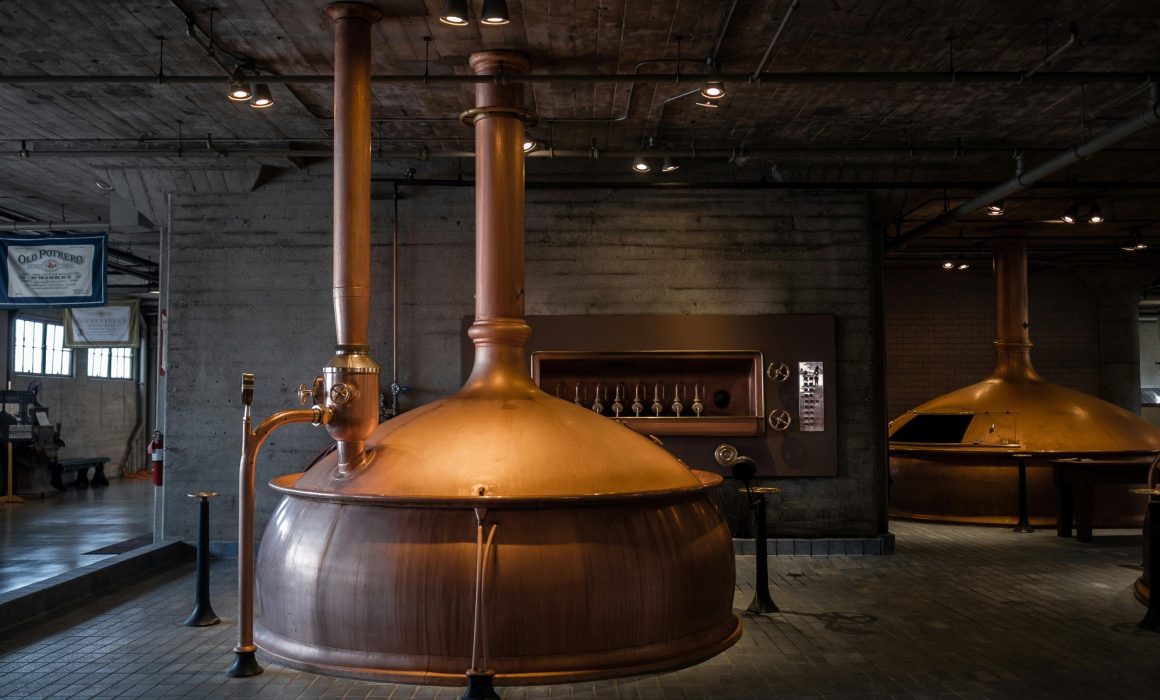Advantages of Copper in Brewing and Economic Reasons to Retrofit
Brewing, an ancient art dating back thousands of years, has evolved into a sophisticated science and industry. While the ingredients, techniques, and equipment have seen significant advancements, one element remains a timeless cornerstone of brewing excellence: copper.
In this article, we will explore the enduring advantages of copper in brewing and the compelling economic reasons to retrofit breweries with this noble metal.
Copper has been intertwined with the history of brewing for centuries, and for good reason. Its unique properties and characteristics play a pivotal role in shaping the flavors, aromas, and overall quality of the final brew. From traditional alehouses to modern craft breweries, copper vessels, and equipment continue to be prized assets in the pursuit of exceptional beer.
Let’s delve into the world of brewing and copper, exploring the advantages of this remarkable material in detail. From its heat conductivity and antimicrobial properties to its aesthetic appeal and sustainability, copper brings a host of advantages to the brewing process.
Features of Copper Kettles
Copper Kettles have several features when it comes to brewing, particularly in the production of beer and other alcoholic beverages. Here are some key features:
- Thermal Conductivity: Copper is an excellent conductor of heat. This property is crucial in the brewing process where precise temperature control is essential. Copper kettles and vats can heat up and cool down quickly, enabling more precise temperature management during the brewing process.
- Natural Antibacterial Properties: Copper possesses natural antibacterial qualities, which is beneficial in a process that requires sterility to prevent contamination. The antibacterial properties of copper help to reduce the risk of unwanted microbes interfering with the brewing process.
- Flavor and Aroma Contributions: Some brewers believe that copper equipment contributes positively to the flavor and aroma of the final product. This is particularly noted in traditional brewing methods, where the interaction between copper and the brewing ingredients is thought to add a unique character to the beer.
- Traditional and Aesthetic Appeal: Copper brewing equipment has a traditional and aesthetic appeal. Many breweries use copper equipment as a nod to traditional brewing methods and also for its visual appeal, which can be a draw for visitors in breweries where the brewing process is on display.
- Durability and Longevity: Copper is a durable material that can withstand the rigors of brewing. With proper care and maintenance, copper brewing equipment can last for many years, making it a long-term investment for breweries.
- Chemical Stability: Copper is chemically stable and does not react with most of the ingredients used in brewing. This ensures that there is no unwanted chemical interaction during the brewing process that could affect the taste or quality of the beer.
Benefits of Copper Kettles
- Enhanced Thermal Conductivity:
- Efficient Heat Distribution: Copper’s superior heat conductivity ensures uniform heat distribution. This is particularly beneficial during the mashing process, where even heating can prevent the formation of hotspots, which can negatively impact the mash.
- Rapid Response to Temperature Changes: Copper’s ability to quickly adjust to temperature changes allows brewers to make swift modifications during the brewing process, ensuring optimal conditions at each stage.
- Antibacterial Properties:
- Inhibits Microbial Growth: Copper’s surface can kill bacteria and yeasts, which is crucial in preventing infections in the brew. This property is especially valuable in environments where cleanliness and sanitation are paramount.
- Reduction in the Use of Chemicals: The antibacterial nature of copper can reduce the need for harsh cleaning chemicals, making the process more environmentally friendly.
- Impact on Flavor and Aroma:
- Unique Taste Profile: Some brewers assert that copper brewing equipment imparts a distinctive taste and aroma, which is often described as “richness” or “fullness” in the flavor profile of the beer.
- Traditional Brewing Techniques: The use of copper is deeply rooted in historical brewing practices. Many traditional beer styles were originally crafted in copper vessels, and some aficionados believe that copper is essential to recreating these classic flavors.
- Aesthetic and Traditional Appeal:
- Visual Attractiveness: Copper’s bright and shiny appearance adds an aesthetic charm to breweries, often becoming a focal point for visitors.
- Historical Significance: Copper’s long history in brewing adds a sense of tradition and authenticity, appealing to consumers who appreciate traditional brewing methods.
- Durability and Longevity:
- Resistance to Corrosion: When properly maintained, copper is resistant to corrosion, which is essential in the acidic environment of brewing.
- Long-Term Investment: The initial cost of copper brewing equipment can be high, but its durability makes it a cost-effective choice in the long run.
- Chemical Stability:
- Non-Reactive with Brewing Ingredients: Copper does not react with the majority of ingredients used in brewing, ensuring that the beer’s flavor remains unaltered.
- Consistency in Brewing Process: The chemical stability of copper contributes to consistency in brewing, which is crucial for maintaining the quality and flavor profile of the beer across different batches.
- Ease of Maintenance and Cleaning:
- Copper is a relatively soft metal: which makes it easier to clean and maintain compared to some other materials. This ease of maintenance is a significant advantage, especially in a process where cleanliness and hygiene are paramount.
- Improved Beer Clarity and Heat Distribution:
- Using copper kettles in brewing: leads to more intense boiling, which can result in clearer beer. The even heat distribution provided by copper helps prevent the scorching of malt, which is crucial for maintaining the quality and consistency of the brew. Copper kettles are often lined with tin to avoid any unwanted reactions between the copper and the beer.
- Antimicrobial Properties and Product Integrity:
- Copper’s antimicrobial properties are particularly beneficial in brewing, where maintaining the purity and integrity of the product is essential. These properties make copper an attractive choice for brewers aiming to ensure the sanitary conditions of their brewing equipment and the final product.
In summary, the use of copper in brewing brings a combination of practical benefits, like thermal conductivity and antibacterial properties, and intangible qualities, such as traditional appeal and aesthetic value. These factors contribute to its continued popularity in the brewing industry, despite the availability of modern alternatives like stainless steel.
Economic Reasons to Retrofitting a Copper Kettle
Retrofitting a copper kettle in a brewery can be a strategic decision driven by various reasons, depending on the specific needs and goals of the brewery. Here are some common reasons to consider retrofitting a copper kettle:
- Modernization: Copper kettles may have been in use for a long time and might lack modern features and technologies. Retrofitting can help bring the kettle up to date with the latest brewing equipment innovations.
- Improved Efficiency: Newer kettles often come with enhanced insulation, heating elements, and temperature control systems, which can lead to improved energy efficiency and faster heating or cooling times.
- Consistency: Upgrading to a modern kettle with precise temperature control and automation can help ensure consistent and repeatable brew batches, leading to better quality and flavor consistency in your beer.
- Increased Capacity: As a brewery grows, it may need to increase its production capacity. Retrofitting a larger copper kettle or adding additional kettles can help meet higher demand.
- Safety Compliance: Meeting safety and regulatory standards is crucial in the brewing industry. Retrofitting can help ensure that your kettle complies with current safety regulations, reducing the risk of accidents.
- Cost Savings: While retrofitting can be an upfront investment, it can lead to long-term cost savings through energy efficiency improvements, reduced maintenance, and increased productivity.
- Enhanced Brewing Techniques: Newer kettles may offer features like whirlpool arms, hop dosing systems, and other brewing aids that can help brewers experiment with new techniques and recipes.
- Sustainability: Many modern kettles are designed with sustainability in mind, incorporating features that reduce water and energy consumption, which can align with a brewery’s environmental goals.
- Conserved Resources: Retrofitting an existing kettle can be more resource-efficient than replacing it entirely, as it allows you to retain valuable materials like copper while improving functionality.
- Adaptation to New Styles: As consumer tastes evolve and new beer styles gain popularity, retrofitting can enable a brewery to adapt and produce a wider variety of beers to meet market demands.
- Brand Image: A shiny, upgraded copper kettle can be a focal point in a brewery and contribute to the overall aesthetics and brand image, potentially attracting more customers.
- Increased Brew Day Efficiency: Modern kettles may offer features such as built-in pumps, automated lautering, and precise controls, making brew days more efficient and less labor-intensive.
Before proceeding with a retrofit, it’s essential to conduct a thorough cost-benefit analysis and consider the specific needs and goals of your brewery. Additionally, consulting with experts like PRO Engineering / Manufacturing Inc. in brewery equipment and design can help you make informed decisions about the retrofitting process.
RESOURCES:
- PRO Engineering / Manufacturing Inc: PROWM.com
- Official Government Portals:
- USA.gov: The U.S. government’s official web portal, providing information on federal agencies, elected officials, and services.
- Health and Healthcare:
- Centers for Disease Control and Prevention (CDC) (USA): Provides health-related information, including disease prevention, vaccinations, and public health guidelines.
- NHS (United Kingdom): The National Health Service’s official website, offering information on healthcare services and advice.
- Environment and Sustainability:
- Environmental Protection Agency (EPA) (USA): Provides information on environmental regulations, conservation, and resources.
- Department for Environment, Food & Rural Affairs (United Kingdom): Offers resources on environmental policies and sustainability.
ABOUT PRO ENGINEERING / MANUFACTURING INC.
Trusted | Knowledge | Quality
We have been involved in pasteurizers since 1977.
PRO Engineering / Manufacturing Inc. has developed a range of small, medium, and large-sized tunnel & batch pasteurizers to fit the needs of BrewMasters and Beverage Makers. When our customers asked for more compact as well as full-size tunnel pasteurizers, PRO developed models to fit our customers’ needs. Then our customers needed a batch pasteurizer. We now provide batch pasteurizers; PRO is a business that continually innovates to meet customer needs.
For more than 40 years, we have been delivering solutions for beverage product shelf stability and consumption safety.
Edward A. Michalski CEO
Ed Michalski started his career in the beverage industry by designing stainless steel, higher flow, spray headers for Pabst Brewing. Along with the header design he also developed a process to produce the new headers.
Ed, along with his brother David, formed PRO Engineering / Manufacturing Inc. Based on what they learned by re-designing and refurbishing other manufacturers’ pasteurizers, Ed and PRO started to offer the pasteurizer marketplace superior new pasteurizers. PRO Engineering / Manufacturing Inc. has been designing and manufacturing great pasteurizers for over four decades.
For more information on tunnel and batch pasteurization contact PRO Engineering / Manufacturing, Inc. at [email protected] or call (414) 362-1500 and ask for Ed Michalski, CEO.
Partner with a PRO!… PRO Engineering / Manufacturing Inc.
Internal Resources:


